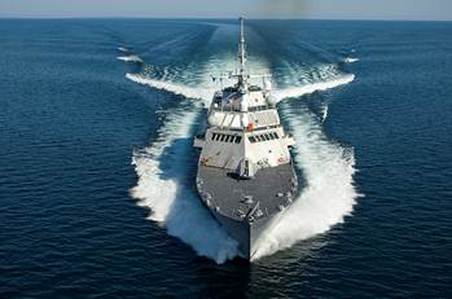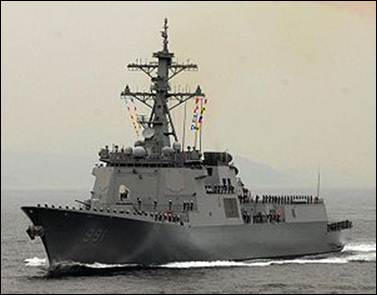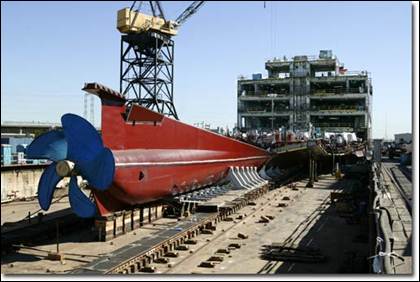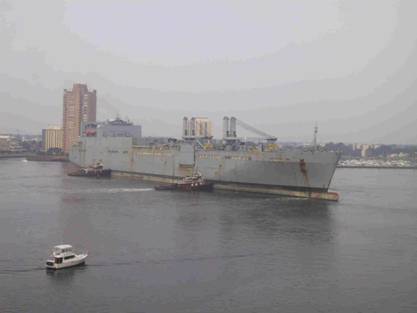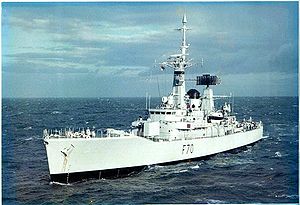Military Vessels
|
|
USS Constellation (FFG-62 Class)The USS Constellation (FFG-62 Class) is a new class of guided missile frigates for the US Navy based on the Italian / French FREMM multipurpose frigate as the parent design. The Constellation class frigates will use the same power dense GE LM2500+G4 gas turbine as the Italian Navy Carlos Bergamini class FREMM frigates, in a Combined Diesel Electric and Gas turbine (CODELAG) propulsion system. The CODELAG arrangement allows both shafts to be driven separately or independently by a single LM2500+G4 gas turbine and / or via electric motors.
Fincantieri Marinette Marine (FMM) was contracted to design and build this next generation frigate. LamaLo has been contracted by FMM to provide expertise on the propulsion shafting system design review and perform shafting analyses with respect to alignment and vibration. |
USS Freedom ClassThe USS Freedom is the lead ship of Littoral Combat Ships (LCS) built at Marinette Marine Corporation (MMC). It is a small specialized variant of the DD(X) family of future surface combat ships. The USS Freedom is 378 feet long with a displacement of about 3000 tons. It is driven by a quartet of waterjets linked to a Combined Diesel & Gas Turbine (CODAG) power plant with a pair of MT30 gas turbines, providing sufficient propulsive power for the vessel to reach over 40 knots.
LamaLo Technology Inc. has been contracted by MMC to provide Specialized Engineering Analysis and Measurement services with respect to the propulsion shaft alignment and vibration. Alignment procedures were developed and executed by LLT for this complex shafting system. During sea trials LLT conducts extensive shafting vibration measurements (Whirling, Torsional & Longitudinal). This system includes 6 shaft torque meters, 3 longitudinal shaft displacement transducers, and 4 shaft whirling measurements. Near real-time display and assessment of the shafting vibration characteristics are provided. The USS Freedom (LCS-1) was commissioned in 2008, the USS Fort Worth (LCS-3) in 2012. LCS-5, 7, 9, 11,13, 15, 17, 19,21,23 & 25 have been delivered as of 2023. LLT continues to support the construction and maintenance of this Class of vessel. |
USS Independence ClassThe Littoral Combat Ship (LCS) Independence Class vessels are a small specialized variant of the DD(X) family of surfac combat ships. The trimaran design employs an aluminum hull and is driven by a quartet of steerable waterjets each individually connected to a prime mover. The vessels are 418 feet in length and designed to make speeds in excess of 40 knots. The vessel has 4 individual shaftlines, each with its own reduction gearbox and prime mover.
LamaLo Technology Inc. was contracted to provide Specialized Engineering Analysis and Measurement services with respect to the propulsion shafting vibrations, powering and bearing performance characteristics. During sea trials LLT conducted extensive shafting vibration and bearing performance measurements (Shafting Whirling, Torsional & Longitudinal; Bearing Temperatures and Water Supply Pressures). Near real-time display and assessment of the measurements were provided during trials, and extensive post analysis and reporting were conducted. LLT continues to support this Class of vessel. |
RCN Protecteur Class (JSS)The Protecteur Class Joint Support Ships (JSS) are a new class of two multi-role ships being built by Seaspan’s Vancouver Shipyards for the Royal Canadian Navy (RCN). These new ships will increase the range and endurance of naval task group missions by providing replenishment at sea (RAS) capabilities, as well as serve as a home base for helicopter maintenance and repair. The JSS will replace the former Protecteur-class auxiliary oiler replenishment (AOR) vessels that served the RCN until 2016.
JSS is the largest ship being built in Canada and will have a length of 173.7m and a beam of 24m. The displacement of the JSS will be approximately 20,240t, with a draft of 8.0 m. The JSS will have a twin-screw propulsion system. Each propeller will be driven by a diesel engine through a reduction gearbox. THMCS Protecteur and its sister ship is designed to achieve a maximum speed of 20kt and a cruising speed of 15kt. LamaLo was contracted to provide Specialized Engineering Analysis and Measurement services with respect to the propulsion shafting design review, and shaft alignment. |
USNS John Lewis (T-AO-205) Class Oiler
|
General Dynamics NASSCO is constructing six John Lewis (T-AO-205) Class Oilers. The vessels will be a double hulled replacement for the Henry Kaiser (T-AO 187) Class, have capacity to carry 156,000 barrels of oil, dry cargo and aviation capabilities while reaching a speed of 20 knots. LamaLo has been contracted to provide expertise on the propulsion shafting system design review and analysis, shaft alignment and shafting vibration analysis (axial and lateral). As of February 2024, alignment measurements on the 4th ship this class were initiated.
|
Fast Missile CraftFour (4) Ambassador IV-class Fast Missile Craft (FMC) are under construction by VT Halter Marine. The vessels are 61 m long and incorporate ship signature control technology. High speed and manoeuvrability are two of their primary assets, and the vessels also incorporate numerous combat system assets and electronic sensors that give them capabilities in anti-aircraft, anti-surface, and electronic warfare. The propulsion is provided by four MTU 16V 595 TE90 diesel engines (each rated at 4.32 MW) driving and four shafts for a design maximum speed of over 30 knots. LamaLo Technology Inc. was contracted to provide expertise on the shafting system design, installation, alignment and vibration. Sea trials on the first of the class were conducted in the Fall of 2012. LamaLo was contracted for the shafting vibration measurements and assessment (torsional, axial, and lateral), as well as the powering performance measurements. The shafting powering and alignment performance to date has been excellent.
|
USNS Howard O. LorenzenThe USNS Howard O. Lorenzen (T-AGM 25 ) missile range instrumentation ship is the support platform for the Cobra Judy Replacement (CJR) radar program designed to provide worldwide, high-quality, high-resolution, multi-wavelength radar data. The Lorenzen is 12,575 tons, 534 feet long, has a beam of 89 feet and a single screw propeller configuration. The keel was laid during a ceremony on August 13, 2008, and the vessel became operational in 2014. LamaLo Technology Inc. was contracted to provide expertise on the shafting system design, installation, alignment and vibration. LamaLo was contracted for the shafting vibration measurements and assessment (torsional, axial, and lateral), as well as the powering performance measurements. The shafting powering and alignment performance to date has been excellent.
|
US Navy Expeditionary Sea Base (ESB) VesselsInitially classed as a Mobile Landing Platform (MLP). These vessels are intended to serve as a transfer station or "floating pier at sea," improving the U.S. military's ability to deliver equipment and cargo to areas where port access is limited or unavailable. The MLP is to have a length of 239 m a beam of 50 m, a ballast draft of 9 m, a loaded draft of 12m, and a sustained speed of 15 knots with a range of 9,500 nm. The vessel has a twin screw propulsion configuration. Each of the 4 bladed fixed pitch propellers are driven by an electric motor rated at 13,400 HP at 85 RPM. The vessels were re-classified as a Expeditionary Sea Base (ESB) vessels. ESB ships are highly flexible platforms designed to support multiple maritime-based missions, including Air Mine Counter Measures (AMCM), Special Operations Forces (SOF), and limited crisis response. Acting as a mobile sea base, this 784-foot ship has a 52,000 square-foot flight deck to support MH-53, MH-60, MV-22 tilt-rotor, and H1 aircraft operations. LamaLo Technology Inc. has been contracted to provide expertise on the propulsion shafting system design review and analysis, shaft alignment and shafting vibration analysis (torsional, axial and lateral). The sixth vessel of this Class was christened in 2021.
|
KDX III ClassThe Republic of Korea Navy KDX-III destroyer is intended to be a multi-purpose destroyer featuring anti-air warfare, anti-surface warfare, anti-submarine warfare and tactical ballistic missile defence capabilities. The KDX-III propulsion system consists of two controllable pitch propellers (twin screws) powered by a Combined Gas turbine and Gas turbine (COGAG) propulsion system, providing 120,000 SHP altogether. LamaLo Technology Inc. was contracted by Aker Yards Marine Inc. to provide expertise on the propulsion shafting system design review and analysis.
|
T-AKE Class (1 x 11262 kW)T-AKE Class Ships are under construction at National Steel and Shipbuilding Company (NASSCO). The vessels are to be 689' long with a displacement of 41,000 long tons and a design speed of 20 knots. The T-AKE 1 is a dry cargo/ammunition ship, the lead ship in the Lewis and Clark class. The mission of the vessel is to provide supplies to carrier battle groups and other forces, serving as a shuttle ship or station ship. The vessel has a single screw propeller configuration. The 5 bladed fixed pitch propeller is driven by two tandem, synchronous, variable speed, reversible, double-wound, 6.6 kV propulsion motors with brush/slip ring excitation, each rated at 11,262 kW at 120 RPM. LamaLo Technology was contracted to do the following:
|
T-AKR 310 Class (2 x 23880 kW)The T-AKR 310 Class Strategic SeaLift Ships, are 950' long and have twin screw propeller configurations, each rated at 32,000 HP (23,880 kW). The vessels are part of the Military Sealift Command's nineteen Large, Medium-Speed Roll-on/Roll-off Ships and are part of the 42 ships in the Pre-positioning Program. Large, Medium-speed, Roll-on/Roll-off Ships, or LMSRs, can carry an entire U.S. Army Task Force, including 58 tanks, 48 other track vehicles, plus more than 900 trucks and other wheeled vehicles. The ship carries vehicles and equipment to support humanitarian missions, as well as combat missions. The new construction vessels have a cargo carrying capacity of more than 380,000 square feet, equivalent to almost eight football fields. In addition, LMSRs have a slewing stern ramp and a removable ramp, which services two side ports making it easy to drive vehicles on and off the ship.
The main strut bearing on the starboard propulsion shaft of the first vessel, the USNS Watson failed in service and the shaft was seized in the fall of 1998. A main strut bearing on the second vessel, the USNS Sisler, experienced excessive water contamination. LamaLo Technology was contracted to do the following:
|
ELSV Class (2 x 2,260 HP)The U.S. Army Enhanced Logistic Support Vessels (ELSV-7 & 8) were constructed at VTHalter Marine Shipyard at Moss Point, Mississippi. The vessels are 314 ft. long with a 60 ft. beam and an overall depth of 19 ft. The ELSV class are able to beach and unload cargo to floating and elevated causeway systems at the beach. The vessels have a twin screw propeller configuration. Each of the 5 bladed fixed pitch propellers is directly driven by a diesel engine rated at 2,260 HP at 1600 RPM, through a single reduction reversible gearbox. The propulsion shaftline is approximately 46 ft. long, and is supported by a strut, a sterntube, and a pillow block bearing. The main gear shaft is supported by two bearings.
LamaLo Technology Inc. was contracted to ensure that the propulsion shaftline installed alignment condition is satisfactory for all modes of operation. This was accomplished by a combination of theoretical modeling, design review and assessment, and on-site measurements. Theoretical alignment and whirling vibration analyses were conducted prior to the installation of the shafting system. An alignment procedure was produced, which included the strain gauge alignment method. The shaftline was roughly aligned using optical techniques and a gap and sag measurements at the gearbox-lineshaft flange connection. The strain gauge technique was used to conduct the final alignment. Jack-up load tests were also conducted on the pillow block bearings as an independent check on the results from the strain gauge alignment results. Alignment measurements were taken again with the machinery near operating temperature. The second ship was delivered in 2004 and the shafting performance has been reported to be excellent on both ships. |
USNS Impeccable (TAGOS-23 Class)
|
USNS Red Cloud (2 x 23880 kW)The USNS Red Cloud is a US Navy T-AKR 310 Class Strategic Sealift ship. It is the fourth vessel in a series of eight vessels that were constructed at NASSCO shipyards in San Diego, California. Maersk Shipping Ltd contracted LLT to conduct an investigation to determine the source(s) of high aft strut bearing temperatures, and to provide the recommended course of action. A “Systems Engineering” approach was applied. All aspects of the shaftline alignment and vibration were investigated by using a combination of analytical modeling, on-site measurements, and documentation review. The work was carried out at Sembawang Shipyards in Singapore. The cause of the high temperature was determined and addressed.
|
HMNZS CANTERBURY - Y-160 Leander Class Frigate Systems Engineering analysis to produce a solution to prevent the excessive wear down of the bearings, and to ensure that the propulsion system is aligned “properly” when the vessel is waterborne and fully outfitted, for all modes of operation. A theoretical alignment analysis was conducted. The requirements for measurement of the alignment condition using the strain gauge technique were produced, along with the algorithms to compute the bearing loads from measured strains. An Excel spreadsheet, which allows the user to compute the bearing loads from strain readings, was provided to the Royal New Zealand Navy.
|

